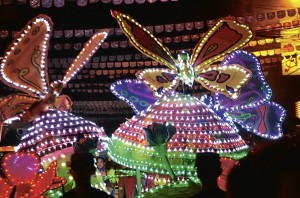In Tacloban, a double treat of festivals
TACLOBAN CITY—Tacloban residents and visitors were treated to two colorful but competing festivals held two days apart in the run-up to the city’s main fiesta celebration in honor of its patron, Senior Sto. Niño, on June 30.
The rivalry between the Pintados-Kasadyaan Festival of Festivals and the Sangyaw Festival has deepened the political rift between their respective sponsors, the provincial government led by Leyte Gov. Jericho Petilla and the city government led by Mayor Alfred Romualdez.
So far, efforts to merge them have not been successful.
The Tacloban fiesta is observed during the whole month of June although the feast day of Sto. Niño de Tacloban is only on June 30. Sometimes, the celebration starts in the last week of May and ends in the first week of July.
The Pintados-Kasadyaan Festival of Festivals was held on June 27 at the grandstand of Leyte Sports Center, which was filled to the rafters by people who were enthralled and thrilled by the dance numbers of colorfully attired Pintados and Kasadyaan contingents.
Article continues after this advertisementAs in last year, its organizers were not issued a permit by the City Hall to hold the event on the streets.
Article continues after this advertisementOn June 29, the city government featured the Parade of Lights during the Sangyaw Festival. Around 20 floats adorned with light-emitting diodes paraded around the city for four hours. Dancers in colorful costumes trailed each float.
Thousands of people lining up the streets were fascinated by the glowing, well-designed floats, which headed for Balyuan Amphitheater for the group dancing contest.
Festival of festivals
- A float of flying butterflies is among the 20 floats that joined the Parade of Lights during the Sangyaw Festival on June 29 in Tacloban City. VICENTE S. LABRO
Tacloban City had only one festival, the Sangyaw, before the Edsa Revolution in 1986, which brought down the Marcos regime. Then first lady Imelda Romualdez Marcos, aunt of the incumbent mayor, introduced the event in the late ’70s or early ’80s as a highlight of the city’s fiesta celebration.
When the Sangyaw was stopped after the “people power” uprising, a group of businessmen belonging to Pintados Foundation Inc. came up with the Pintados Festival to showcase Leyte and Samar’s early tattooed inhabitants called Pintados and their rich cultural heritage and indigenous music and dance. The festival was first celebrated on June 29, 1987.
But in 1996, then Leyte Gov. Remedios “Matin” Petilla, mother of the incumbent governor, introduced yet another festival, the Leyte Kasadyaan Festival of Festivals, to attract tourists.
The event, which showcased the unique culture and history of the people of the province, was first held on May 12, 1996, in Tacloban and was participated in by some municipalities. For two years, it was celebrated on different dates.
The Pintados and the Leyte Kasadyaan merged into one big attraction called the Pintados-Kasadyaan Festival of Festivals.
Sangyaw revival
In 2008, when Mayor Romualdez was at the helm of the city government, the city revived the Marcos-era Sangyaw. Performing contingents from the MassKara Festival in Bacolod City, the Sinulog Festival in Cebu City and other popular festivals in the country came during the Sangyaw’s reappearance.
In succeeding years, the Sangyaw featured local “tribes,” which bested each other in a ritual dance competition.
With the rival festival’s revival, the Pintados-Kasadyaan was moved from June 29 to June 27 in 2008.
At Leyte Sports Center, 10 Pintados and 11 Kasadyaan contingents vied for the grand prize. The Lingganay Festival was champion anew, followed by the Pasaka Festival of Tanauan town and the Karatong Festival of Dulag town.
The Lingganay also won grand prize during the Sinulog in January.
Training ground
For producing winners in the Sinulog, the Aliwan Festival in Manila and other similar affairs, the Pintados-Kasadyaan has lived up to its reputation as training ground of festivals.
Tacloban used to hold its fiesta every third Sunday of January, but an incident made it move the celebration to June 30.
In the late 1880s, the Sto. Niño image got lost when a ship bringing it to Manila for face-lifting caught fire. About six months later, Tacloban received news that the box containing the image was found in Mindoro. A retrieval team came back with the image on June 30. People associated that event to the miraculous disappearance of a cholera epidemic that struck Tacloban.
Since then, the fiesta has been celebrated on June 30.

